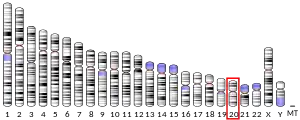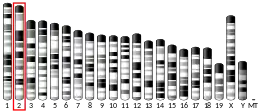ZBP1
Z-DNA-binding protein 1, also known as DNA-dependent activator of IFN-regulatory factors (DAI) and DLM-1, is a protein that in humans is encoded by the ZBP1 gene.[5][6]
| ZBP1 | |||||||||||||||||||||||||||||||||||||||||||||||||||
|---|---|---|---|---|---|---|---|---|---|---|---|---|---|---|---|---|---|---|---|---|---|---|---|---|---|---|---|---|---|---|---|---|---|---|---|---|---|---|---|---|---|---|---|---|---|---|---|---|---|---|---|
| |||||||||||||||||||||||||||||||||||||||||||||||||||
| Identifiers | |||||||||||||||||||||||||||||||||||||||||||||||||||
| Aliases | ZBP1, C20orf183, DAI, DLM-1, DLM1, Z-DNA binding protein 1 | ||||||||||||||||||||||||||||||||||||||||||||||||||
| External IDs | OMIM: 606750 MGI: 1927449 HomoloGene: 10972 GeneCards: ZBP1 | ||||||||||||||||||||||||||||||||||||||||||||||||||
| |||||||||||||||||||||||||||||||||||||||||||||||||||
| |||||||||||||||||||||||||||||||||||||||||||||||||||
| |||||||||||||||||||||||||||||||||||||||||||||||||||
| |||||||||||||||||||||||||||||||||||||||||||||||||||
| |||||||||||||||||||||||||||||||||||||||||||||||||||
| Wikidata | |||||||||||||||||||||||||||||||||||||||||||||||||||
| |||||||||||||||||||||||||||||||||||||||||||||||||||
ZBP1 is also an abbreviation for chicken or rat β-actin zipcode-binding protein 1, a homolog of the human insulin-like growth factor 2 mRNA-binding protein 1 (IMP-1) and murine CRD-BP, the proteins involved in mRNA transport (RNA-binding proteins, RBPs).
Function
DLM1 encodes a Z-DNA binding protein. Z-DNA formation is a dynamic process, largely controlled by the amount of supercoiling.[6] ZBP1 recognizes DNA in the cytoplasm as an antiviral mechanism. Viral life cycles often include steps where DNA is exposed in the cytoplasm. DNA is normally contained in the nucleus of a cell, and therefore cells use proteins like ZBP1 as an indicator of a viral infection. Once ZBP1 is activated, it increases the production of antiviral cytokines such as interferon beta.[7] DLM1 then binds to cytosolic Viral DNA using two Z-DNA-binding domains (Zα and Zβ) at its N-terminus along with a DNA binding domain (D3).[8]
The role of ZBP1 in DNA sensing has been questioned. It has been found to sense Influenza A Virus (IAV) infection and induce cell death. Since DNA is not synthesized in any stage of IAV life cycle, DNA sensing playing a role in this context is unlikely.[9][10] However, recent investigation has found that ZBP1 is capable of sensing Z-form RNAs produced during IAV infection, cumulating in a form of caspase independent, inflammatory cell death called necroptosis.[11]
A follow-up study identified that ZBP1 senses the IAV ribonucleoprotein complex to induce cell death.[10] A more recent study has identified transcription factor IRF1 as the upstream regulator of ZBP1 expression.[12]
Zipcode binding protein 1 (ZBP1) was shown to regulate dendritogenesis (dendrite formation) in hippocampal neurons.[13] This protein is different from the nucleic acid sensor ZBP1.
References
- GRCh38: Ensembl release 89: ENSG00000124256 - Ensembl, May 2017
- GRCm38: Ensembl release 89: ENSMUSG00000027514 - Ensembl, May 2017
- "Human PubMed Reference:". National Center for Biotechnology Information, U.S. National Library of Medicine.
- "Mouse PubMed Reference:". National Center for Biotechnology Information, U.S. National Library of Medicine.
- Rothenburg S, Schwartz T, Koch-Nolte F, Haag F (Feb 2002). "Complex regulation of the human gene for the Z-DNA binding protein DLM-1". Nucleic Acids Research. 30 (4): 993–1000. doi:10.1093/nar/30.4.993. PMC 100341. PMID 11842111.
- "Entrez Gene: ZBP1 Z-DNA binding protein 1".
- Rathinam VA, Fitzgerald KA (Mar 2011). "Innate immune sensing of DNA viruses". Virology. 411 (2): 153–62. doi:10.1016/j.virol.2011.02.003. PMC 3070751. PMID 21334037.
- Ha SC, Kim D, Hwang HY, Rich A, Kim YG, Kim KK (Dec 2008). "The crystal structure of the second Z-DNA binding domain of human DAI (ZBP1) in complex with Z-DNA reveals an unusual binding mode to Z-DNA". Proceedings of the National Academy of Sciences of the United States of America. 105 (52): 20671–6. Bibcode:2008PNAS..10520671H. doi:10.1073/pnas.0810463106. PMC 2634953. PMID 19095800.
- Kuriakose T, Man SM, Subbarao Malireddi RK, Karki R, Kesavardhana S, Place DE, Neale G, Vogel P, Kanneganti TD (August 2016). "ZBP1/DAI is an innate sensor of influenza virus triggering the NLRP3 inflammasome and programmed cell death pathways". Science Immunology. 1 (2): aag2045. doi:10.1126/sciimmunol.aag2045. PMC 5131924. PMID 27917412.
- Kesavardhana S, Kuriakose T, Guy CS, Samir P, Malireddi RK, Mishra A, Kanneganti TD (August 2017). "ZBP1/DAI ubiquitination and sensing of influenza vRNPs activate programmed cell death". The Journal of Experimental Medicine. 214 (8): 2217–2229. doi:10.1084/jem.20170550. PMC 5551577. PMID 28634194.
- Zhang T, Yin C, Boyd DF, Quarato G, Ingram JP, Shubina M, et al. (March 2020). "Influenza Virus Z-RNAs Induce ZBP1-Mediated Necroptosis". Cell. 180 (6): 1115–1129.e13. doi:10.1016/j.cell.2020.02.050. PMC 7153753. PMID 32200799.
- Kuriakose T, Zheng M, Neale G, Kanneganti TD (February 2018). "IRF1 Is a Transcriptional Regulator of ZBP1 Promoting NLRP3 Inflammasome Activation and Cell Death during Influenza Virus Infection". Journal of Immunology. 200 (4): 1489–1495. doi:10.4049/jimmunol.1701538. PMC 6483084. PMID 29321274.
- Perycz M, Urbanska AS, Krawczyk PS, Parobczak K, Jaworski J (Apr 2011). "Zipcode binding protein 1 regulates the development of dendritic arbors in hippocampal neurons". The Journal of Neuroscience. 31 (14): 5271–85. doi:10.1523/JNEUROSCI.2387-10.2011. PMC 6622686. PMID 21471362.
Further reading
- Ha SC, Van Quyen D, Hwang HY, Oh DB, Brown BA, Lee SM, Park HJ, Ahn JH, Kim KK, Kim YG (Feb 2006). "Biochemical characterization and preliminary X-ray crystallographic study of the domains of human ZBP1 bound to left-handed Z-DNA". Biochimica et Biophysica Acta (BBA) - Proteins and Proteomics. 1764 (2): 320–3. doi:10.1016/j.bbapap.2005.12.012. PMID 16448869.
- Schwartz T, Behlke J, Lowenhaupt K, Heinemann U, Rich A (Sep 2001). "Structure of the DLM-1-Z-DNA complex reveals a conserved family of Z-DNA-binding proteins". Nature Structural Biology. 8 (9): 761–5. doi:10.1038/nsb0901-761. PMID 11524677. S2CID 22313681.
- Schwartz T, Rould MA, Lowenhaupt K, Herbert A, Rich A (Jun 1999). "Crystal structure of the Zalpha domain of the human editing enzyme ADAR1 bound to left-handed Z-DNA". Science. 284 (5421): 1841–5. doi:10.1126/science.284.5421.1841. PMID 10364558.




